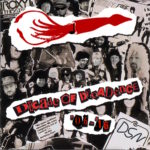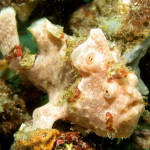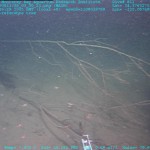This is rewritten from one of my favorite contributions from The Other 95%.
—————————
In November 2003, while an undergrad at University of California at Davis I was asked by my two of my Geology professors if I wanted to help them out on an expedition to hydrothermal vents at the East Pacific Rise. They knew of my interest in vents because I couldn’t shut up about them. My major was in Evolution and Ecology and while I was planning to double major with Geology, it never happened. Two classes shy and I didn’t want to stay an extra semester just for another BS degree.
This expedition was headed by the Field Museum in Chicago as more or less a collecting expedition and other parties with funding came along to share the cruise time. We used the famous Alvin submersible and sailed aboard the R/V Atlantis. Our role as the “geology contingent” was to oversee the night operations which included mapping the seafloor and flying TowCam, the towed camera system that we tried to not crash into the seafloor too many times. TowCam takes a photoat a set time interval and also carries equipment to measure the altitude off the seafloor, distance of objects in front of it, particle scatter in the water column, conductivity, depth and temperature. Except for imagery, all this information is relayed up the cable to the control room where someone has to constantly have their hand on the controls to adjust the feed of the cable, keeping the camera and equipment about 3-5 meters off the bottom. Not an easy task, but needlessness to say the students never crashed while the same could not be said for the two highly experienced professors (rock sample!)… lets just say the close-ups were awesome!
This was mainly a biology cruise though, which was the real reason I was asked to go. I’m not really a geologist, just a biologist with a good deal of geological training. Being the least senior out of everyone on board, I was affectionately referred to by my French colleague as the “ship’s bitch”. I was also in charge of making a “best of” video for the expedition to show off to the Museum’s patrons. Basically pulling out highlights and cool video from each dive.
I truly found my passion was sorting through rocks, sediment, and snot to find those elusive critters. I seemed to be very good at it as the Chief Scientist and the other biologists were always pleased with my findings! Sorting is still something I take great pleasure in. I get all giggly like twihard on opening night when a box full of crap comes up from the seafloor filled with various worms, gastropods, amphipods… its the what-new-thing-might-I-find-if-I-keep-looking mentality that keeps me up all night sifting.
While nights were filled with work, daytime was spent waiting for Alvin to return from the bottom. To pass the time we often peered overboard trying to spot marine life. Often, floating debris from islands or continents far away would pass beside the ship with several colorful fish hidden underneath seeking its protection. One day a coconut floated by. I don’t know whose brilliant idea it was, but one of the biologists netted it for fun I suppose. As it turned out this coconut was full of wonderful surprises!
All the images were taken by my friend and colleague, crustacean biologist T.A. Haney.
Unfortunately, I cannot tell you what any of these are, none of the specimens were in my possession since the end of that cruise. I presume they ended up deposited in the Field Museum along with everything else. The barnacle appears similar to species in the genus Poecilasma, but has lateral plates, which I haven’t seen in Poecilasma. The clam has a massive siphon! It is likely wood-boring clam, also known as shipworms, in the genus Xylophaga. But I think the polychaete steals the show. Good friend of the blog and polychaete specialist, Leslie, had previously identified it as the pelagic amphinomid Hipponoe gaudichaudi.
I just wanted to share these photos because they have fascinated me since I first saw these fully in the technicolor of real life. Each species’ coloring is reminiscent of a coconut. Its almost as if they intended to live inside of a coconut hull and have all independently evolved “cocomouflage”. It is rather uncanny. I think the currents at 8-13°N run east to west and I’m unsure where the equatorial counter current was at that time and that year, but we were probably above it since it typically hovers around 5°N. This microcommunity had to have come from Mexico or Central America or an island offshore. We were about 400km from the coast, so it must have traveled quite far and all the coconauts seemed healthy and responsive. What did they eat in there? Did the species interact? Perhaps the crab was a juvenile, but they all appeared to be adult forms.
Observations like this open so many questions for me about connectivity in the ocean. I often daydream about designing experiments to study floating microcommunities such as this one. Just think of trolling the open seas in transects and picking up anything you can spot and seeing what lives there. There can be more rigorous scientific questions proposed beyond the mere fascination with discovery and natural history. Are there specialist coconut inhabiting fauna? How do floating communities affect the genetic structure of animal species? Is rafting why we see high connectivity among some coastal critters? Can we apply an island biogeographic model to debri-dwelling species and constrain better the frequency of these immigration events. When I read about my colleague and DSN cowriter Miriam’s work, I find it absolutely fascinating. The role of floating debris, whether natural or man-made, is an under-appreciated aspect in marine ecology, in part of the ephemeral nature of the debris. You don’t set out to find debris, it finds you.






I’m envious of you Kevin. I also fancy myself a sifting hobbyist. Up until last week I spent a year working in an echinoderm evodevo lab at Carnegie Mellon. We had aquaria filled with nothing but bat stars, purple sea urchins and california sea cucumbers…and a plethora of tiny little things that live among them. One of my favorite things to do during downtime was to just scrape and pipette the underside of the sea stars. By far the strangest creatures were the polycheate worms and the red-eyed cycloptic copepods that inhabited every star. There’s nothing quite like looking at these critters under a good dissecting scope.
Thanks for sharing.
Nice, my favorite old post from The Other 95%.
Daniel, Pay attention to egg masses in purple sea urchins. When I was teaching intro bio at PSU, I found urchin egg eating nematodes were transported from our supplier out in CA!
From the viewpoint of a total deep sea neophyte, this collection of life inside a floating coconut is jaw dropping! Thank you for sharing a tiny mystery of the deep most of us will never see first hand. Send more, please!